This post contains affiliate links. Please see our disclosure policy.
How to Cook Indian Food without Oil. Dal Tadka Recipe. Restaurant style Lentil soup. Masoor Dal Tadka is one of the better known dals as it is generally available in Indian restaurants. Oil-free Indian cooking.
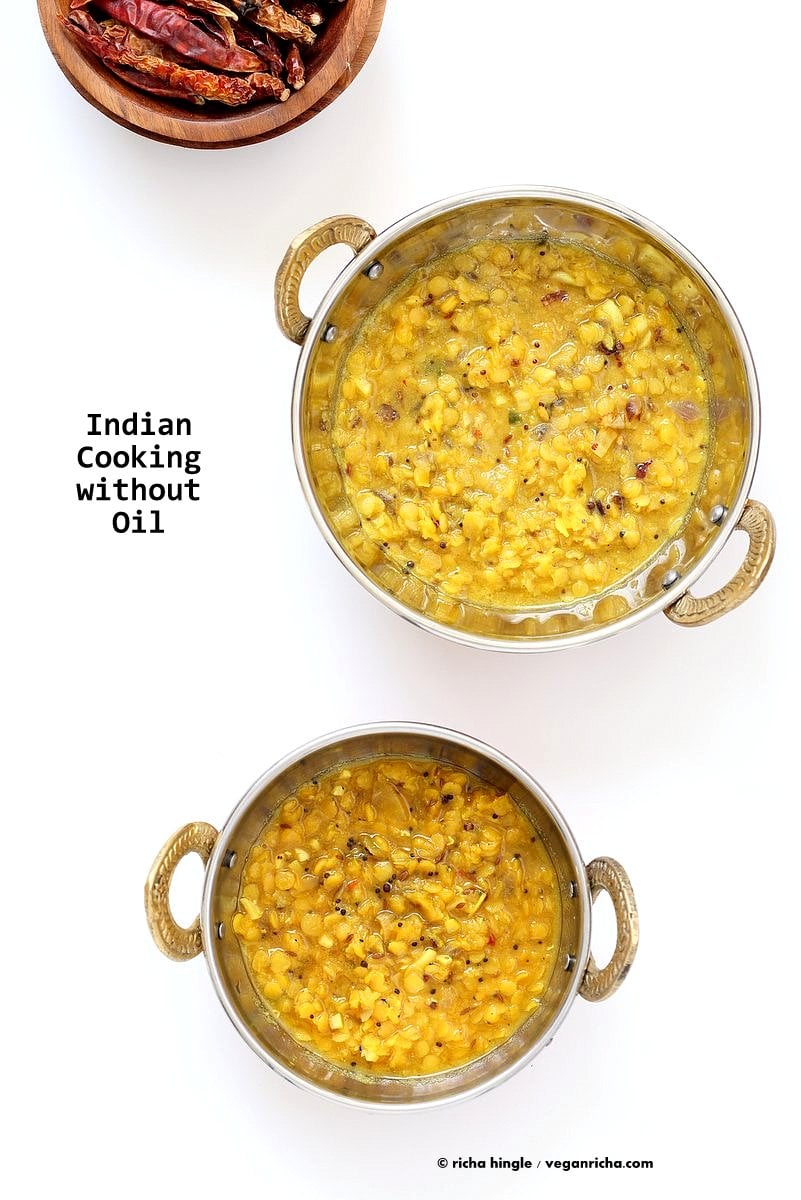
I generally use low amounts of oil in my cooking. Just a fourth or half teaspoon is enough for the tempering (esp with whole spices) or spray for baking or other needs. I often get asked about how to cook Indian food without oil and have been meaning to write up this post for a while, probably months now. I cooked some dishes without oil to figure out what works best in terms of tempering whole spices, ground spices, how some traditional Indian recipes would need some adjustment and so on.
Here is how to adjust Indian recipes to be oil-free. These adjustments also apply to cooking oil-free in general.
Whole spices:
Whole spices are often tempered in hot oil in many Indian dishes like Dals, one pot meals, mains etc. When the oil is hot, spices are added to it. They are cooked until they get fragrant or change color or start to pop. At this point the spices infuse the oil really well and the oil acts as a carrier to infuse the rest of the dish.
To temper the whole spices without oil, the tempering process can get divided into more than 1 step or the order of the recipe is changed.
1. You can dry roast the spices until they change color and continue with the rest of the steps of the recipe. Use water or broth to saute onions/veggies once the spices are roasted.
2. You can dry roast the spices, remove them from the pan, and add them back to the pan with the ground spices. This reduces the risk of burning the whole spices.
3. You can change the recipe and use ground versions of the whole spices listed. The ground spices will then be added later in the recipe with other ingredients as turmeric.
For option 1, Heat the skillet over the heat mentioned in the recipe without oil. When the skillet is hot, add the whole spices in the order mentioned in the recipe, and cook them until they get fragrant, or change color or start to pop. Yes they will start to pop, it might take a bit longer than when cooked in hot oil. Once the spices are tempered, add a splash of water or broth to bring the temperature of the pan down so the spices do not burn and also to infuse the broth/water. Add onions or curry leaves or whatever the next step. Keep adding more water or broth to cook the onions or veggies and continue with the recipe.
Notes:
1. Burnt spices: Dry roasting the spices to the expected outcome (popping) can easily go from roasted spices to burnt spices. Burnt spices will add a strong smoky bitter flavor that might or might not work with the dish. If unsure, roast the spices till just about starting to get fragrant or the slightest color change.
If roasted whole spices always turn out bitter, use ground spices instead and add them later in the recipe when you add other ground spices. Or if you are not so particular about traditional flavors, add whole spices directly later in the recipe with liquids. Spices, whole or ground, dry roasted, oil roasted, broth cooked, or unroasted, add different flavors to the final dish. Find the flavors and method that work the best for you.
2. Order of roasting: Some spices roast and burn faster than other spices. Often the recipes will already have this information even when cooking in oil. If the information is not there, and there are many whole spices used in the recipe, you can dry roast each spice separately. Or if you know the general roasting times of the whole spices, then add them to the pan in order of longest to shortest roasting time. For eg mustard seeds will take longer to roast compared to cumin seeds. Larger spices will also take longer to roast.
3. Amount: Sometimes the flavor might still feel like it doesnt infuse well enough. Use more of the whole and ground spices. When doubling spices, double all except heat(cayenne, black pepper, red chilies) so that the overall flavor balance of the dish stays the same. ‘
One of the below Dal Tadka has tempering made without oil and the other tempered in oil. They look pretty much the same. Taste wise, there will be a difference. The oil-free dal tastes better after a few hours as the spices take longer to infuse.
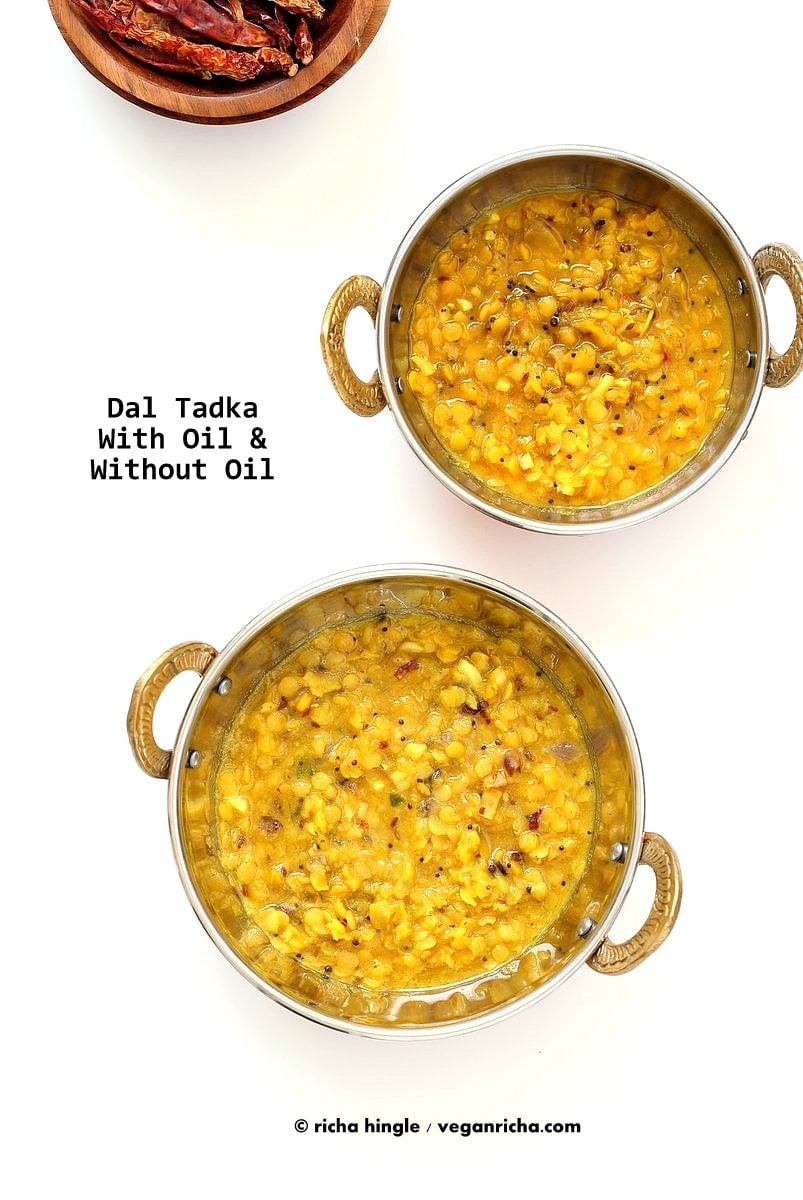
Ground Spices:
You can cook ground spices in broth or lightly dry toast and then add broth or water. It depends on the recipe. If the ground spices are added later in the recipe, the contents of the pan might already be wet. If not, then mix the spices in broth/water and add to the skillet.
If you often cook without oil, make your own ground roasted spices. Roast the whole spices like cumin seeds, coriander seeds until fragrant, cool, grind and store. Make small amounts to use up within a month or 2. This eliminates the need to roast the spices during the recipe. The pre-packaged spices might not necessarily be roasted.
Cooking onion , garlic or other vegetables:
Use water or broth to saute the onions or vegetables until translucent or golden as the recipe needs.
Depending on the pan used, the onions, veggies or tomatoes will have a tendency to stick or burn. Add additional water or broth to help reduce the sticking.
I use Ecolution Terra pans, and they work beautifully for cooking oil-free. Nothing sticks on them if cooked at the right heat and the pans are cared for. Cast iron would also be a great choice.
Asafetida:
Asafetida (hing) is often tempered in oil with whole spices or right after the whole spices are tempered. Asafetida has a really fetid aroma and flavor. Once tempered however it becomes garlick-onion kind of flavor which supports the other flavor profiles in the dish. Without oil, you want to roast the asafetida on a dry skillet. Adjust the time when you add asafetida in the recipe so that, 1. it is roasted on a dry skillet 2. it is roasted only for a few seconds as it will burn quickly.
Curry Leaves:
Fresh Curry leaves have a beautiful flavor profile which is mixture of lime, coriander and other flavors. The strong flavor infuses the oil during tempering and is carried over to the dish. Often the leaves are discarded while eating (not before), as it depends on personal preference. Many people eat the curry leaves while most discard the leaves.
Add curry leaves later in the recipe, as adding them at the step mentioned in With-oil recipe will only dry them out. Add them with the onions, or add them directly to the lentils/liquid.
Frying:
For my cookbook, I worked on all the usually fried recipes ( Fritters/Pakoras, Manchurian, koftas, Gulab Jamuns etc) to convert them to baked versions. The recipes were developed and optimized to make Crisp and similar texture and flavor baked results. Those recipes use a small amount of oil in the batter or for brushing during baking. They can easily be made oil-free by omitting the oil. Be sure to use parchment paper to avoid things sticking to the baking sheet. Aquafaba or non dairy milk brushed on will help things like kofta balls be more moist.
In general, for baking Indian recipes that are deep fried, adjust the batter to be thicker than what is used for frying.
To make flatbreads without oil, use non dairy yogurt in the dough to help keep the breads moist and pliable. Use a good skillet to cook the flatbreads.
What are your tips to cook Indian or other cuisines oil-free?
Get the recipe for Oil-free Dal Tadka below. Original with-oil Dal tadka recipe is in my cookbook Vegan Richa’s Indian Kitchen. Tips to get started with Indian cooking here.
Oil free Dal Tadka - Restaurant style Lentil soup
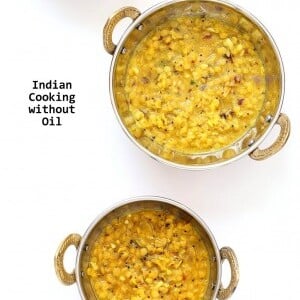
Ingredients
- 1 cup red lentils, masoor dal, quick cooking lentils, or use other split peas or lentils of choice
- 2.5 cups water
- 3/4 to 1 tsp salt
- 1/2 cup finely chopped red or white onion
- 5 cloves of garlic, finely chopped
- 1 inch ginger, chopped
- broth or water as needed
- 1/2 tsp turmeric
- 1 tsp ground coriander
- 1/2 to 1 tsp garam masala
- 1/2 tsp dried fenugreek leaves kasoori methi
- 1 tsp cumin seeds
- 1/2 tsp mustard seeds
- a generous pinch of asafoetida hing, Omit to make gluten-free or use certified gluten-free asafetida
- 2 dried red chilies, broken into half (cayenne or california red)
- 8 curry leaves
- 1 bay leaf
Instructions
- Wash and drain the red lentils. Add to a deep pan with water and salt. Bring to a boil on medium heat, then cook on medium-low heat for 12-15 minutes or until lentils are tender. Keep them on a low simmer. See Note for Instant Pot instructions.
- Heat a skillet over medium heat. Add onion, garlic, ginger and a pinch of salt. Mix and cook for 6 to 8 minutes or until golden brown. Add a splash of water or broth if the onions begin to stick or brown too quickly.
- Add turmeric, coriander, garam masala and fenugreek leaves. Mix and cook for half a minute. Add a splash of water if sticking. Pour this into the cooked simmering lentils.
- Heat a clean skillet over medium heat, when the skillet is hot, mustard seeds and cook for a few seconds. Add cumin seeds and mix. Cook until the cumin seeds slightly change color and get fragrant. The mustard seeds will change color but might not pop. Add red chilies, bay leaf and cook until the bay leaf starts to change color. Add asafetida and curry leaves and mix in (If you were using oil, asafetida + curry leaves would be added with the chilies). Add this tempering to the cooked lentils. Mix well and take off heat. Taste and adjust salt and spice. Add more water for thinner consistency. Serve hot garnished with cilantro, with Naan, flat breads or rice.
Notes
Use 2 to 2.5 cups of other cooked lentils or cooked split peas. Instant Pot: Combine the drained red lentils, salt and water in the Instant Pot or pressure cooker. Close the lid to sealing and cook for 1 minute Manual on high pressure. Quick release after 5 minutes.
For other split peas or whole lentils, adjust cooking time accordingly. Make the tempering (step 2 onwards) and fold in. Nutritional values based on one serving
Nutrition
Nutrition information is automatically calculated, so should only be used as an approximation.
Let me know in the comments if you have tips and tricks that you usually use to convert recipes to oil-free.
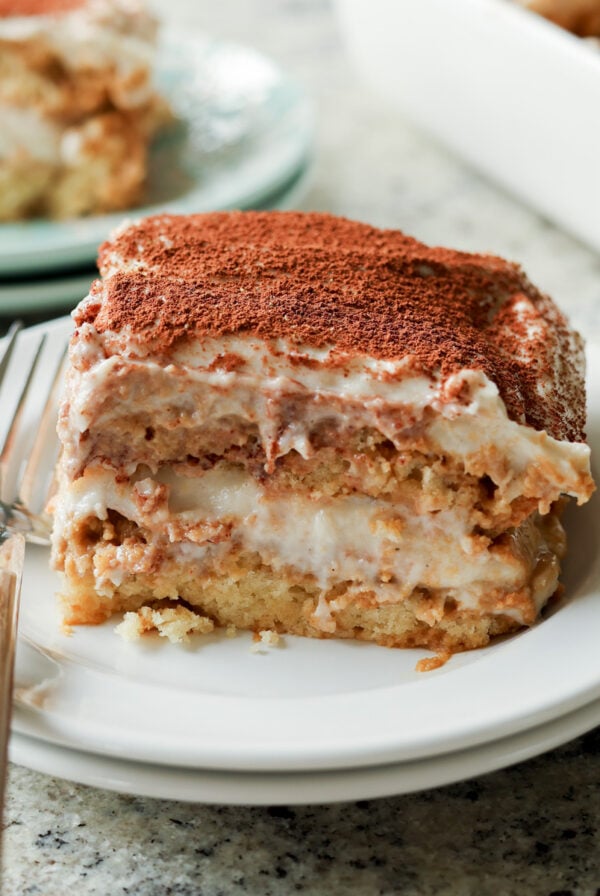
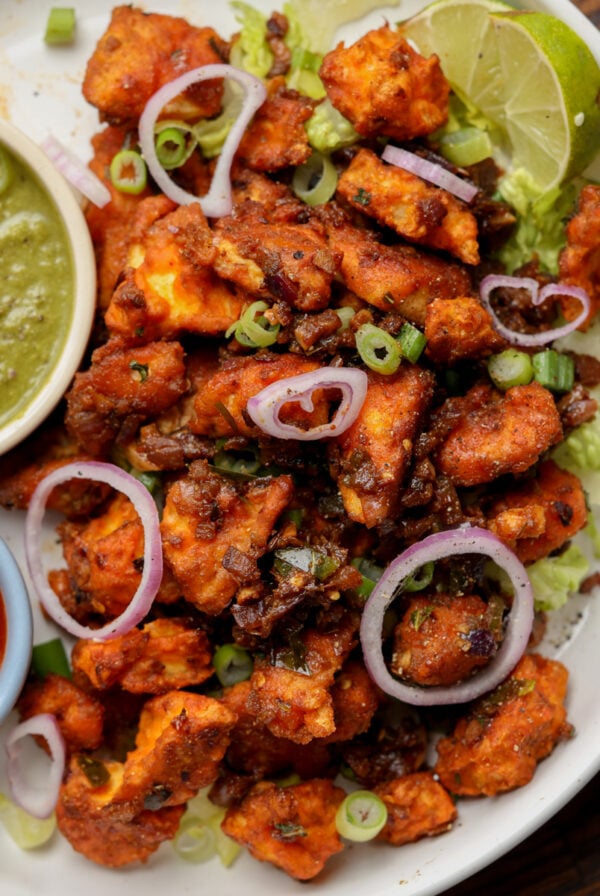
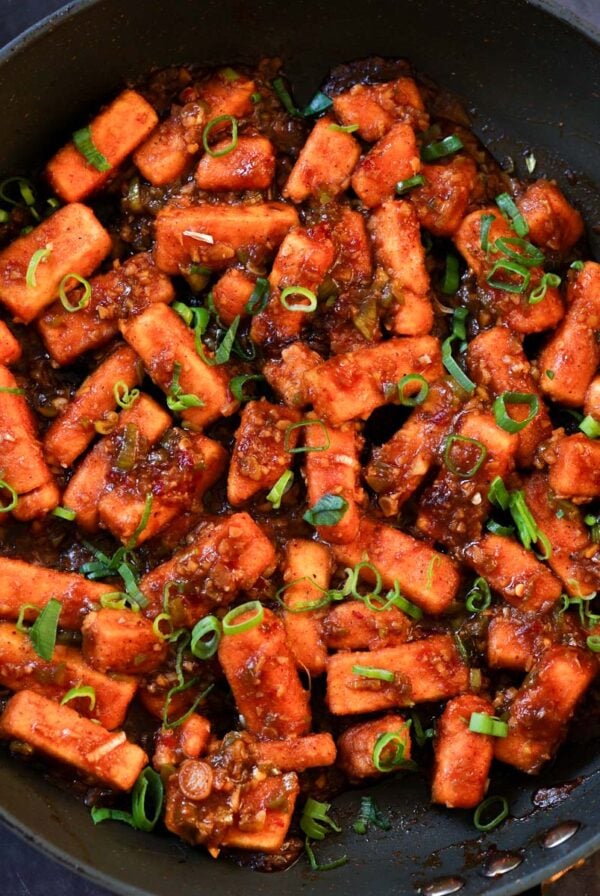
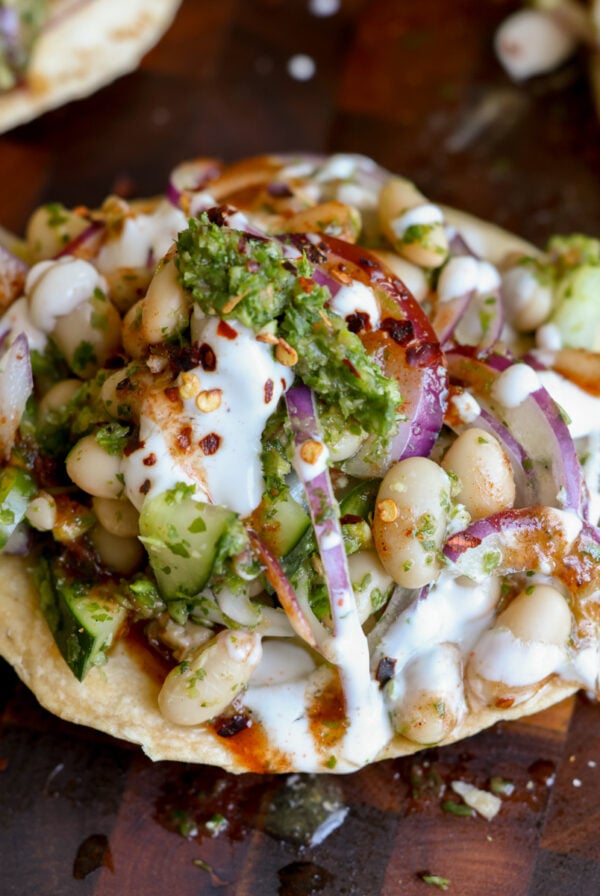






Hi Richa,
Huge fan! We have a lot of colleagues in common. I have been teaching vegan cooking classes for 30 years. Sold your books in my classes. I’ve been oil free for several years and I now have to cook without acidic food for a month! So hard without garlic, onions, peppers and tomatoes! My moong dal recipe calls for all of the above of course. I can use ginger, turmeric (but I use curcumin which is lower in oxalates), and cumin seeds, and I have asaetida to sub for onions. The onions usually get cooked with the moong dal, and the aromatics get cooked in a skillet with a bit if water. Wondering if it’s better to add asafetida to dal or to aromatics or both? It definitely won’t be the moong dal that is a staple in my house but I hope it will be palatable. I value your input! Happy to email you the recipe (e-dress?). Thanks!
Oops I can also use leeks!
Thank you! wow. I would add it to the dal
I’m excited to try your oil-less method next time I cook and I hope it works! *fingers crossed*
I made Jamaican curry chicken tonight and it did not turn out the way it’s supposed to. I’m not sure if it is because I didn’t fry the curry first. But, it’s also a different type of curry than I’m used to. I did cook it in water on high but that may not have been good enough.
it will turn out great
Love it. Tried to cook some dishes without oil with the help of the tips in this post. Amazing. Love ur vegan cakes n goodies too. V helpful post!
Thank you for stopping by!
This is so much better than any I’ve had in a restaurant. Thank you so much for my new favorite recipe.
Thank you so very, very much for giving us this oil free recipe. Indian food is my very favorite, and it helps keep me vegan because it is so spicy and delicious. I just cannot thank you enough for offering us these hints and tips for creating our favorite Indian recipes without oil. Of course it will lack the richness that we are used to when we are eating in Indian restaurants, But it is such a huge gift for helping us to seek health. I love your recipes, I love your food, thank you so much for this gift, and this information.
Thank you Susan. Everyday home cooked indian food is generally unlike Indian restaurant even when made with oil. Restaurants stick o a few sauces and add a lot more crream, oil, butter and spices while home cooked Indian food uses much less of all of that. it is lighter, fresher flavor with a few spices to showcase he spices or thee veggies etc
Y’all!! This absolutely delicious!! I’ve been looking for a good tadka dal recipe that I hope would come close to the one I order at an indian restaurant but this exceeds even that! This beyond restaurant-quality. This is a recipe made with love. I swear I cooked this like seven times in a course of two weeks and I don’t get tired of it. Thank you!! and loving greetings from Belgium xxxx
yay!
This is awesome! I was looking for a vegan oil free indian recipe and you did it!
Thank you so much!
A little late to the party, but I have also been experimenting with this. Whenever I dry roast spices there is a remaining taste of “rawness”. I believe this is because many of the compounds in spices are not water soluable. So no matter how long you cook them in water you will never achieve the same taste profile. (Please correct me if I am wrong here).
I am still trying different things. No fat would be ideal. But if you just want to get rid of the bitternes / raw spice taste you can also cook the spices in cashew cream. Soften a handful of cashews in boiling water for 20 minutes or cold water for 4-5 hours (or overnight) then blend them with a little bit of water (say 1/2 cup cashews to 1 cup water) until there are no lumps. So you get a thick and smooth milk or cream. Put the cream into a pan and bring to a boil. Add all the spices and cook for about 4-5 minutes. The cream gets really gloopy like a paste. What happens is that the water evaporates and the spices infuse their compounds into the cashew fat.
Then just add the rest of the ingridients and cook.
I have also had success with coconut cream, but prefer the cashews.
Thanks for the wonderful book 🙂
Yes that should help. If you cook the raw spices for a longer time withthe onions or the sauce, the fat in the ingredients will help infuse as well. The main difference is that the spices get roasted faster and infuse the food faster hen tempered in the oil. So you want to dry roast them on a dry skillet over low heat for longer until well roasted. Higher heat will burn them. and then use more spices and cook them longer with the sauce base as well. some extra fat of whatever kind will help too
I have been cooking oil less Indian food for years. I do the roasting of spices like you have mentioned.
I love all your recipes and made pastry with garbanzo over the holidays and it was a hit.
Thanks for providing the frying hints. I got a new air fryer and want to try it out and will follow your suggestions.
Thanks again for your healthy recipes.
Thanks!
Thank u so much for the tips. I tried the tadka dal n trust me, u dont have to wait for an hour for the taste, it tastes yumm. Thank u 😊🌹